Share with us how you customize your recipes to "Make It Mine"
Everything You Need to Know Before Cooking with Salt Pork

I remember growing up in the Boston area and salt pork was a staple in the kitchen. If my mother was frying fish she would render the salt pork and fry a nice piece of fresh haddock rolled in corn meal in the rendered fat. Just doesn't taste the same in vegetable oil. And the best part of it was the crunchy, salty little pork bits that were on the side of the fish. Delicious! So whether it's Boston Baked Beans, New England Clam Chowder or fried fish, you really need to start using salt pork.
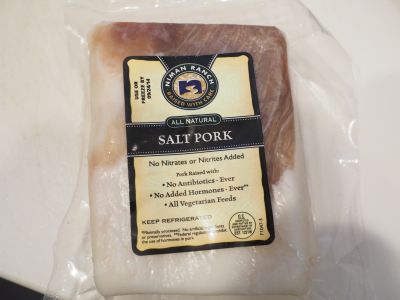
1. What is Salt Pork? >>
2. Selecting Salt Pork >>
3. Preparing Salt Pork >>
4. Cooking with Salt Pork >>
5. Frying Salt Pork >>
1. What is Salt Pork?
Salt pork is similar to bacon in its appearance. It can be made from the pork side, the pork belly or the fatback of the pig which is the layer of fat under the skin on the back of the pig. Most readily available salt pork is made from pork belly which will produce a product that is a combination of meat and fat to mostly fat.
Salt pork is similar to bacon in that both are salt cured first but with salt pork, that's the end of the process. Bacon is further cured and smoked giving it a completely different flavor. Salt pork is more similar to pancetta which is the Italian version of bacon and is sold in rolls. Pancetta typically has more meat than salt pork and is cured with salt and herbs to give it a different flavor.
Experiment with salt pork, bacon and pancetta and see which flavor profile you like best. And each certainly has it's place in the kitchen and in your recipes. Salt pork is a very traditional ingredient in New England recipes like Boston Baked Beans and New England Clam chowder.
2. Selecting Salt Pork
There are three variables to consider when selecting salt pork. First, and maybe the least important because in most cases this is decided for you, is the cut of the pork; whether it is from the side, the belly or the back. Second is the quality of the pork; whether it is from a large commercial manufacturer or an artisanal producer, whether it has been treated with chemicals, what it has been fed and generally how it lived its life. Third is the curing method; whether it is cured with salt crystals or brining liquid and whether it contains sodium nitrite or curing salt which is what gives it the distinctive red color.
I don't think you need to go crazy in your hunt for salt pork unless you really have a preference for artisanal products. The traditionally salt cured artisanal product will have a stronger flavor and the meat will be a brownish color. You will also be able to feel the salt when you remove it from the package. The more readily available commercial products will have that reddish color to the meat that looks more like bacon and there will be no salt crystals present on the product.
I encourage you to try the different cuts and sources of salt pork in your recipes. It may be considered an acquired taste but once you learn how to incorporate it, you will be glad you did.
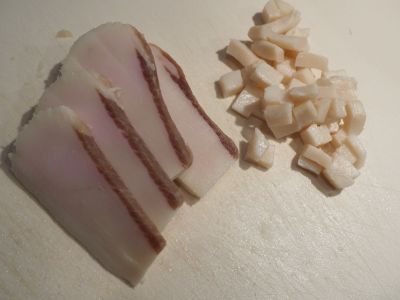
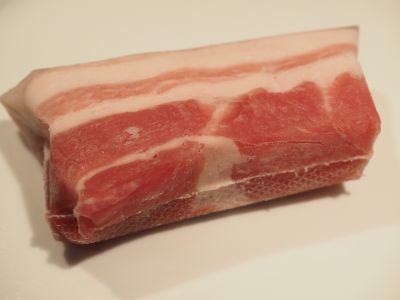
3. Preparing Salt Pork
Salt pork usually comes in block form but sometimes will be sold already sliced like bacon. If you are using commercially brined salt pork and you don't see or feel any visible salt on the product it is ready for use. If you are using an artisanal product and it has salt on the outside, you can rinse the salt off before using it. Some people will soak it or parboil it, especially if it is the featured part of the dish and is not being used as a background flavor.
Next you need to decide whether you want it sliced or cubed and how thick you want those pieces. Once you have it cut up you are ready to get cooking.
4. Cooking with Salt Pork
Salt pork is used in one of three ways. You can use it to render fat as the basis for sauteing vegetables at the start of a dish. You can put it into a dish like beans where it will add fat and flavor during the cooking process. And last, in the past people used to cure the salt pork as a means of preservation and then use it as a main dish. If you are going to do this I would recommend that you start with plain pork belly and cure or marinate it yourself. So for purposes of this discussion we will focus on frying it and using it in cooked dishes.
When you fry salt pork just as you would bacon, there will be two byproducts from the cooking process. Rendered fat left in the pan, and the bits or slices of salt pork that will be salty, crispy, golden in color and delicious. The rendered fat will add tremendous flavor to any dish you are making such as clam chowder. And speaking of clam chowder, serve it with oyster crackers and the little bits of salt pork. It will make the dish very special.
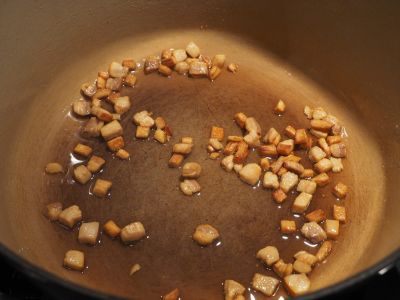
If you are adding the salt pork to a dish like baked beans or black eyed peas, you will want to prepare it in large cubes or strips. Add it right in with all the other ingredients, or just in the water if you are boiling green beans, and it will add a lot of flavor and a velvety texture to the dish.
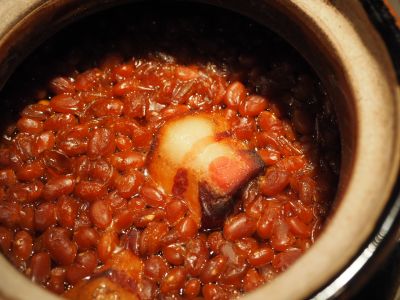
5. Frying Salt Pork
Here's what you do to fry salt pork.
- Cut the salt pork into 1/4 - 3/8 inch cubes
- Add them to a heavy bottom pot, preferably the pot in which you will be making the recipe
- Turn the heat to medium high
- Fry the cubes until the fat is rendered and the cubes are crispy, like bacon
- Remove the cubes with a slotted spoon and place on a plate lined with a paper towel, reserve for later use
- Continue your recipe using the rendered fat in the pan
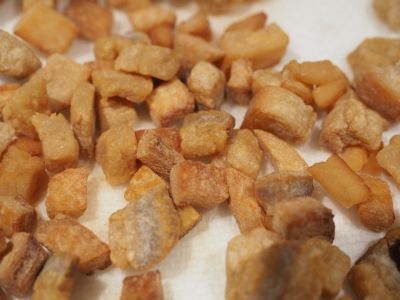
Summary
So however you decide to use salt pork in your recipes, experiment with it and enjoy it!
Check out the BostonSidewalks recipe for New England Clam Chowder where we use salt pork for rendered fat and for the little cracklings to use as a garnish to the chowder. Or maybe try the Boston Baked Beans where we use it to flavor and add texture to the dish.
Share Your Opinion of this Recipe and How You "Make It Mine"
We're very glad you have chosen to share your thoughts. It's what we're all about. (All comments are moderated)
Please enter your name so people will know which comments are yours. You can use your real name or pick a user name if you prefer. To subscribe to our newsletter, enter your email address. And we never share any of your information with anyone, EVER! And if you submit a rating it must be accompanied by a comment and a name to be counted.
Get Our Newsletter!
Recent Comments
Meat Loaf
The meatloaf was moist, smooth and cooked perfectly through. The glaze was different but terrific...a nice change. Totally recommend and I give 5 s...
Eileen -- 5/17/18
I boil mine in the pressure cooker for 5 minutes, the easiest eggs to peel
Kori -- 4/10/18


